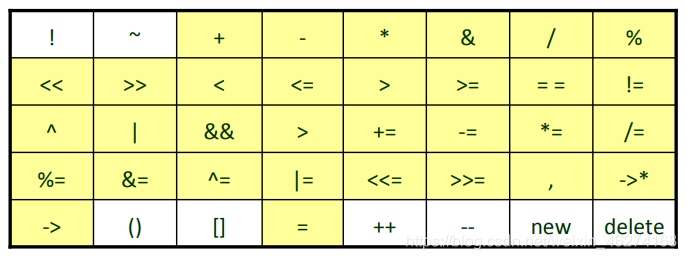C++中运算符重载详解及其作用介绍
概述
函数重载
运算符重载
C++ 的运算符
重载运算符的规则
成员函数实现 Complex 加法
运算符重载的方法
多种实现方法
实现 operator+=
三种运算符重载函数
成员函数实现
友元函数实现
输出结果
重载单元运算符
例子
重载二元运算符
例子
重载 I/O
插入运算符 <<
提取运算符 >>
总结
概述运算符重载 (Operator Overloading)

重载: 将同一名字重新赋予新的含义.
函数重载: 对一个函数赋予新的含义, 使之实现新功能. 例如:
int max(int x, int y);
double max(double a, double b, double c);
运算符也有重载: 赋予运算符新的含义, 使之一名多用. 例如
int main() {
int i = 2, j = 3;
int k = i + j;
string s1 = "good ", s2 = "morning";
string s3 = s1 + s2;
cout << k << endl;
cout << s3 << endl;
return 0;
}
运算符重载输出结果:
5
good morning
通过运算符重载, 扩大了 C++ 已有运算符的作用, 使运算符能用于类对象. 使用运算符重载, 能使程序易于编写, 阅读和维护. 运算符被重载后, 其原有的功能仍然保留, 没有丧失过改变.
运算符重载实质上是函数的重载:
定义一个重载运算符的函数
需要执行被重载的运算符时, 系统就自动调用该函数, 以实现相应的运算
C++ 的运算符算数运算符: +(加) -(减) *(乘) %(整除余数) ++(自加) – (自减)
关系运算符: >(大于) <(小于) ==(等于) >=(大于等于) <=(小于等于) !=(不等于)
逻辑运算符: &&(逻辑与) ||(逻辑或) !(逻辑非)
位运算符: <<(按位左移) >>(按位右移) &(按位与) |(按位或) ∧(按位异或) ~(按位取反)
赋值运算符: = 及其扩展赋值运算符
条件运算符: ?:
都好运算符: ,
指针运算符: *
引用运算符合地址运算符: &
求字节数运算符: sizeof
强制类型转换运算符: (类型) 或 类型()
成员运算符: .
指向成员的运算符:->
下标运算符: []
其他: 如函数调用运算符 ()
重载运算符的规则不允许创造新的运算符, 只能对已有 C++ 运算符进行重载.
C++ 允许重载运算符: 成员运算符(.), 成员指针访问运算符(.*), 域运算符(:😃, 求字节数运算符(sizeof), 条件运算符(?😃
重载不能改变运算符运算对象 (即操作数) 的个数
重载不能改变运算符的优先级别
重载不能改变运算符的结合性
重载运算符的函数不能有默认的参数
重载的运算符必须和用户定义的自定义类型的对象一起使用. 参数至少有一个是类对象或其 引用
成员函数实现 Complex 加法Complex 类:
#ifndef PROJECT2_COMPLEX_H
#define PROJECT2_COMPLEX_H
class Complex {
private:
double real;
double imag;
public:
Complex();
Complex(double r, double i);
Complex add(Complex &c2);
void display();
};
#endif //PROJECT2_COMPLEX_H
Complex.cpp:
#include <iostream>
#include "Complex.h"
using namespace std;
Complex::Complex() : real(0), imag(0) {}
Complex::Complex(double r, double i) : real(r), imag(i) {}
Complex Complex::add(Complex &c2) {
Complex c;
c.real = real + c2.real;
c.imag = imag + c2.imag;
return c;
}
void Complex::display() {
cout << "(" << real << ", ";
cout << imag << "i)" << endl;
}
main:
int main() {
Complex c1(3, 4), c2(5, -10), c3;
cout << "c1 =";
c1.display();
cout << "c2 =";
c2.display();
c3 = c1.add(c2);
cout << "c1 + c2 = ";
c3.display();
return 0;
}
输出结果:
运算符重载的方法c1 =(3, 4i)
c2 =(5, -10i)
c1 + c2 = (8, -6i)
运算符重载格式:
函数类型 operator 运算符名称 (形参流标) {对运算符的重载处理}
Complex 类:
#ifndef PROJECT4_COMPLEX_H
#define PROJECT4_COMPLEX_H
class Complex {
private:
double real;
double imag;
public:
Complex();
Complex(double, double);
void display();
Complex operator+(Complex &c2);
};
#endif //PROJECT4_COMPLEX_H
Complex.cpp:
#include <iostream>
#include "Complex.h"
using namespace std;
Complex::Complex() : real(0), imag(0) {}
Complex::Complex(double r, double i) :real(r), imag(i) {}
void Complex::display() {
cout << "(" << real << ", ";
cout << imag << "i)" << endl;
}
Complex Complex::operator+(Complex &c2) {
Complex c;
c.real = real + c2.real;
c.imag = imag + c2.imag;
return c;
}
main:
#include <iostream>
#include "Complex.h"
using namespace std;
int main() {
Complex c1(3, 4), c2(5, -10), c3;
cout << "c1 =";
c1.display();
cout << "c2 =";
c2.display();
c3 = c1 + c2;
cout << "c1 + c2 = ";
c3.display();
return 0;
}
输出结果:
多种实现方法c1 =(3, 4i)
c2 =(5, -10i)
c3= (8, -6i)
成员函数实现:
Complex Complex::operator+(Complex &c2) {
Complex c;
c.real = real + c2.real;
c.imag = imag + c2.imag;
return c;
}
简化:
Complex Complex::operator+(Complex &c2){
return Complex(real +c2.real, imag + c2.image);
}
友元函数实现:
Complex operator+(Complex &c1, Complex &c2){
......
}
实现 operator+=
Complex 类:
#ifndef PROJECT4_COMPLEX_H
#define PROJECT4_COMPLEX_H
class Complex {
private:
double real;
double imag;
public:
Complex();
Complex(double, double);
void display();
Complex operator+=(const Complex &c);
};
#endif //PROJECT4_COMPLEX_H
Complex.cpp:
#include <iostream>
#include "Complex.h"
using namespace std;
Complex::Complex() : real(0), imag(0) {}
Complex::Complex(double r, double i) :real(r), imag(i) {}
void Complex::display() {
cout << "(" << real << ", ";
cout << imag << "i)" << endl;
}
Complex Complex::operator+=(const Complex &c) {
real += c.real; // this->real += c.real;
imag += c.imag; // this->imag += c.imag;
return *this;
}
main:
#include <iostream>
#include "Complex.h"
using namespace std;
int main() {
Complex c1(3, 4), c2(5, -10), c3;
cout << "c1 =";
c1.display();
cout << "c2 =";
c2.display();
c1 += c2;
cout << "c1= ";
c1.display();
return 0;
}
输出结果:
三种运算符重载函数c1 =(3, 4i)
c2 =(5, -10i)
c1= (8, -6i)
运算符重载函数可以是类的成员函数:
它可以通过 this 指针自由地访问本类的数据成员. 少写一个函数的参数, 但有要求.
运算符重载函数可以是类的友元函数:
如果运算符左侧的操作属于 C++ 标准类型 (如 int) 或是一个其他类的对象, 则运算符重载函数不能选用成员函数. 为方便访问类的私有成员, 声明为友元函数为佳.
运算符重载函数还可以是普通函数:
只有极少的情况下才使用 (因普通函数一般不能直接访问类的私有成员)
成员函数实现Complex 类:
#ifndef PROJECT4_COMPLEX_H
#define PROJECT4_COMPLEX_H
class Complex {
private:
double real;
double imag;
public:
Complex();
Complex(double, double);
void display();
Complex operator+(double d); // 成员函数实现
};
#endif //PROJECT4_COMPLEX_H
Complex.cpp:
#include <iostream>
#include "Complex.h"
using namespace std;
Complex::Complex() : real(0), imag(0) {}
Complex::Complex(double r, double i) :real(r), imag(i) {}
void Complex::display() {
cout << "(" << real << ", ";
cout << imag << "i)" << endl;
}
Complex Complex::operator+(double d) {
return Complex(real + d, imag);
}
友元函数实现
Complex 类:
#ifndef PROJECT4_COMPLEX_H
#define PROJECT4_COMPLEX_H
class Complex {
private:
double real;
double imag;
public:
Complex();
Complex(double, double);
void display();
friend Complex operator+(Complex &c, double d); // 友元函数
};
#endif //PROJECT4_COMPLEX_H
Complex.cpp:
#include <iostream>
#include "Complex.h"
using namespace std;
Complex::Complex() : real(0), imag(0) {}
Complex::Complex(double r, double i) :real(r), imag(i) {}
void Complex::display() {
cout << "(" << real << ", ";
cout << imag << "i)" << endl;
}
Complex operator+(Complex &c, double d) {
return Complex(c.real + d, c.imag);
}
输出结果
main:
#include <iostream>
#include "Complex.h"
using namespace std;
int main() {
Complex c1(3, 4), c2(5, -10), c3, c4;
cout << "c1 =";
c1.display();
cout << "c2 =";
c2.display();
c3 = c1 + 3.14;
cout << "c3= ";
c3.display();
return 0;
}
输出结果:
重载单元运算符c1 =(3, 4i)
c2 =(5, -10i)
c3= (6.14, 4i)
单元运算符 (unary operation), 即只有一个运算量. 如: !a, -b, &c, *p, ++i, i-- 等.
例子重载单元运算符实现分数对象的相反数.
Fraction 类:
#ifndef PROJECT4_FRACTION_H
#define PROJECT4_FRACTION_H
#include <iostream>
using namespace std;
class Fraction {
private:
int nume; // 分子
int deno; // 分母
public:
Fraction();
Fraction(int, int);
Fraction operator-(const Fraction &c); // 分数相减
Fraction operator-(); // 取反一目运算
friend ostream& operator<<(ostream &output, const Fraction &f);
};
#endif //PROJECT4_FRACTION_H
Fraction.cpp:
#include "Fraction.h"
Fraction::Fraction() : nume(0), deno(0) {}
Fraction::Fraction(int n , int d) : nume(n), deno(d) {}
Fraction Fraction::operator-(const Fraction &c) {
return Fraction(nume*c.deno - c.nume*deno, deno*c.deno);
}
Fraction Fraction::operator-() {
return Fraction(-nume, deno);
}
ostream& operator<<(ostream &output, const Fraction &f) {
double result = (double)f.nume / f.deno;
output << result << endl;
return output;
}
main:
#include <iostream>
#include "Fraction.h"
using namespace std;
int main() {
Fraction f1(1,3), f2(1,5), f3, f4;
f3 = f1 - f2; // 分数相减
f4 = -f1; // 分数取反
cout << f3;
cout << f4;
return 0;
}
输出结果:
重载二元运算符0.133333
-0.333333
二元运算符 (binary operation).
有两个操作数, 通常在运算符的左右两侧 (例如: 3+2, 5>8, x*=3)
重载双目运算符时, 函数中应该有两个参数

要求:
定义字符串类 String, 用来存放不定长的字符串
重载关系运算符, 用于两个字符串的比较运算
步骤:
定义类的 “框架”
完善运算符重载
String 类:
#ifndef PROJECT4_STRING_H
#define PROJECT4_STRING_H
#include <cstdlib>
class String {
private:
char *p;
public:
String(){p=nullptr;}
String(char *str);
void display();
};
#endif //PROJECT4_STRING_H
String.cpp:
#include <iostream>
#include <cstring>
#include "String.h"
using namespace std;
String::String(char *str) {
p = new char[sizeof(str)];
strcpy(p, str);
}
void String::display() {
cout << p;
}
main:
#include <iostream>
#include "String.h"
using namespace std;
int main() {
String s1("Hello");
String s2("China");
s1.display( );
cout<<" ";
s2.display( );
cout<<endl;
return 0;
}
输出结果:
重载 I/OHello China
通过重载输入流 (input stream) 和输出流 (output stream), 我们可以用来输出用户自己定义的数据.
格式:
ostream &operator<<(ostream&, const 自定义类&);
istream &operator>>(istream&,自定义类&);

Complex 类:
#ifndef PROJECT4_COMPLEX_H
#define PROJECT4_COMPLEX_H
#include <iostream>
using namespace std;
class Complex {
private:
double real;
double imag;
public:
Complex();
Complex(double, double);
void display();
Complex operator+(Complex &c);
friend ostream& operator<<(ostream &output, const Complex &c);
};
#endif //PROJECT4_COMPLEX_H
Complex.cpp:
#include <iostream>
#include "Complex.h"
using namespace std;
Complex::Complex() : real(0), imag(0) {}
Complex::Complex(double r, double i) :real(r), imag(i) {}
void Complex::display() {
cout << "(" << real << ", ";
cout << imag << "i)" << endl;
}
Complex Complex::operator+(Complex &c) {
return Complex(real + c.real, imag + c.imag);
}
ostream &operator<<(ostream &output, const Complex &c) {
output<<"("<<c.real<<" + "<<c.imag<<"i)";
return output;
}
main:
#include <iostream>
#include "Complex.h"
using namespace std;
int main() {
Complex c1(2, 4),c2(6, 10),c3;
c3 = c1 + c2;
cout << c1 << " + " << c2 << " = " << c3 << endl;
return 0;
}
输出结果:
提取运算符 >>(2 + 4i) + (6 + 10i) = (8 + 14i)
Complex 类:
#ifndef PROJECT4_COMPLEX_H
#define PROJECT4_COMPLEX_H
#include <iostream>
using namespace std;
class Complex {
private:
double real;
double imag;
public:
Complex();
Complex(double, double);
void display();
Complex operator+(Complex &c);
friend ostream& operator<<(ostream &output, const Complex &c);
friend istream& operator>>(istream &input, Complex &c);
};
#endif //PROJECT4_COMPLEX_H
Complex.cpp:
#include <iostream>
#include "Complex.h"
using namespace std;
Complex::Complex() : real(0), imag(0) {}
Complex::Complex(double r, double i) :real(r), imag(i) {}
void Complex::display() {
cout << "(" << real << ", ";
cout << imag << "i)" << endl;
}
Complex Complex::operator+(Complex &c) {
return Complex(real + c.real, imag + c.imag);
}
ostream &operator<<(ostream &output, const Complex &c) {
output<<"("<<c.real<<" + "<<c.imag<<"i)";
return output;
}
istream &operator>>(istream &input, Complex &c) {
cout << "input real part and imaginary part:\n";
input >> c.real >> c.imag;
return input;
}
main:
#include <iostream>
#include "Complex.h"
using namespace std;
int main() {
Complex c1, c2;
cin >> c1 >> c2;
cout << "c1=" << c1 << endl;
cout << "c2=" << c2 << endl;
return 0;
}
输出结果:
总结input real part and imaginary part:
2 4
input real part and imaginary part:
6 10
c1=(2 + 4i)
c2=(6 + 10i)
运算符重载使类的设计更加丰富多彩, 扩大了类的功能和使用范围. 运算符重载使得程序易于理解, 易于对对象进行操作. 有了运算符重载, 在声明了类之后, 我们就可以像使用标准类型一样来使用自己声明的类.
类的声明往往是一劳永逸的. 有了好的类, 用户在程序中就不必定义许多成员函数去完成运算和 I/O 的功能, 使主函数更加简单易读. 好的运算符重载能细心啊面向对象程序设计思想.
到此这篇关于C++中运算符重载详解及其作用介绍的文章就介绍到这了,更多相关C++运算符重载内容请搜索软件开发网以前的文章或继续浏览下面的相关文章希望大家以后多多支持软件开发网!